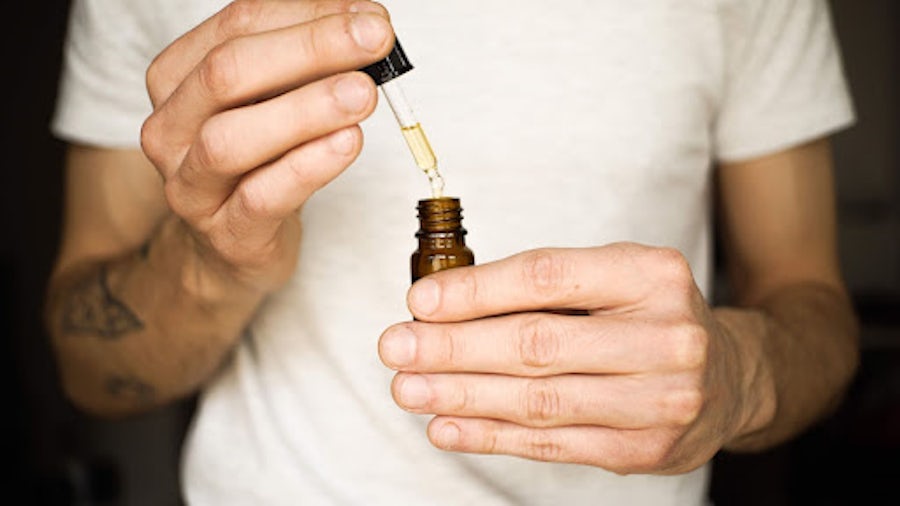Rick Simpson Oil (RSO) is a concentrated cannabis extract with high levels of THC.
RSO rose to fame in online forums as a purported pain killer, cancer treatment, and overall “miracle cure” for a variety of ailments. While this product is of great interest to many people seeking alternative medical treatments, only anecdotal evidence supports these claims. There are no clinical studies behind RSO.
So, what exactly is Rick Simpson Oil?
Rick Simpson Oil is an ultra-concentrated crude cannabis oil. The oil is dark with a dense, thick consistency, closer to grease than oil. Rick Simpson’s website defines RSO as “extremely potent decarboxylated extract produced from strong sedative indica strains, which have THC levels in the 90% range.”
RSO is a generic, popularized term that has come to mean any crude cannabis oil that is decarboxylated and dispensed in a syringe. In reality, there is no formal definition of RSO or how it must be made to call something RSO.
While most products called RSO use some type of an alcohol extraction, there are also products on the market being made with hydrocarbon extraction as well. Even Rick Simpson’s first oils were made with an industrial blend of hydrocarbons known as naphtha, often found in paints and rubber solvents. RSO is considered a “whole-plant extract,” meaning it contains THC as well as other cannabinoids, flavonoids, and other plant molecules like waxes chlorophyll; however, RSO typically contains low terpene content due to how it is processed.

Because of this process, RSO is also typically dark green or brown, a stark contrast to the lighter colors of THC distillate and isolate. According to Mr. Simpson, true RSO should be between 90% and 95% THC, which makes it hard to find in the retail market but also challenging to extract at home.
In reality, extracts of purity exceeding 80-90% are difficult to make at home and often require advanced equipment, so it’s unlikely that any homemade product would be this potent.
Difference between RSO and FECO
Since the term RSO is a generic term often used to describe highly concentrated, crude cannabis oil often marketed to cancer patients, it comes with plenty of hype and stigma. To be more accurate, we prefer to use the term FECO (full extract cannabis oil) RSO is often used interchangeably with FECO , but these are not necessarily the same products.
FECO and RSO are essentially the same product, a crude cannabis extract often sold in a syringe. However the primary difference between the two is that FECO is almost always ethanol, whereas RSO is a more generic term and could be made using isopropyl alcohol, ethanol, hydrocarbon solvents and even CO2. In the end, there is no clear definition for these crude extracts, and each solvent will have its own unique properties that extract certain chemicals from the plant better than others.
FECO is generally considered safer than RSO because ethanol is generally safer for consumption than isopropyl alcohol or naphtha, both known for being flammable and toxic (though naphtha is worse in both regards). 1 2 3
Is RSO the same as QWISO?
QWISO, or Quick Wash ISOpropyl, is a solvent-based extraction method for making concentrates. The only difference between RSO and QWISO is the original extraction method for RSO used naphtha (hydrocarbon) instead of isopropyl. In fact, the recipe for RSO on Rick Simpson’s website is actually a QWISO recipe. If you make RSO using isopropyl alcohol, you are making a QWISO concentrate, sometimes called isopropyl hash oil QWISO hash oil.
How to make your own RSO
Important: Heating alcohol or naphtha is dangerous. These liquids are extremely flammable when heated, which can cause damage and personal injury.
- always work in a space with proper airflow
- if you choose to make RSO at home, whether you use an electric stove or a rice cooker, do not leave it unattended and do not let it get too hot
- do not, under any circumstance, use a gas stove or have an open flame near these solvents – the process of heating the RSO will produce gasses that could easily ignite if exposed to flame
Since RSO can be challenging to come by in some legal markets and nearly impossible to find in illegal markets, many people choose to make their own.
Here’s how Simpson suggests making his oil:
Ingredients
- 1 lb. dried cannabis. A pound of flower will yield 60 grams, which should be enough for the 90-day treatment Simpson recommends.
- This flower should be high-quality, THC-rich (>15%) cannabis.
- If desired, high-CBD flower could be used with this recipe
- 2 gallons of isopropyl alcohol — ideally 91% or higher (medical or pharmaceutical-grade)
- note: Simpson’s original recipe calls for naphtha, but he has since been modified to use isopropyl alcohol
- A large bucket, large bowl, and wooden spoon
- Cheesecloth
- Rice cooker (optional)
- Syringe
Instructions
- If you’re not using a rice cooker, decarboxylate your cannabis.
- Crumble the cannabis and combine with one gallon of alcohol into a large bowl and mix gently. After a few minutes, the THC will be dissolved in the solvent.
- Pour the solvent through the cheesecloth and into the bucket.
- Add more isopropyl alcohol into the bowl with the plant material and mix gently.
- Again, strain the solvent through the cheesecloth into the bucket. Discard the plant material.
- Pour the infused solvent into your rice cooker and turn it to 220°F or the low setting. Allow the solvent to evaporate, keeping a close eye on it. Simpson recommends running a fan aimed at the rice cooker to prevent flammable fumes from building up and coming into contact with the heating element.
- If you aren’t using a rice cooker, your solvent will need to evaporate for significantly longer.
- The solvent evaporation is finished when a few inches of dark, thick oil are left in the rice cooker. Remove the oil with a spatula or a syringe. Store in an airtight container in a cool, dark place.
Health warning: Isopropyl alcohol and naphtha are recommended by Simpson, but ingestion of these liquids is dangerous. The above method does not guarantee these liquids have been wholly extracted off. Ingesting isopropyl alcohol or naphtha can result in vomiting, abdominal pain, dizziness, intestinal bleeding, and other organ damage. Take care to ensure all solvent has been evaporated.
How to use RSO
As a highly-concentrated extract, RSO shouldn’t be vaped or smoked (RSO is made with flammable extracts and smoking could be dangerous, especially if the solvent was not properly purged). Instead, you should consume it orally, sublingually, or through topical application. Since RSO is dense and sticky, you can mix the oil with a small amount of coconut oil for ease of application.
Some people create capsules with RSO to avoid the strong cannabis taste, while others add it to food and drinks. You can use RSO in cooking the same way as cannabutter or by adding it to the finished dish.
But how much should you take? On his website, Simpson suggests patients:
- Slowly increase their dosage over three months, beginning with “three doses per day,” each of them “about the size of a half a grain of short grained dry rice.”
- Double this amount every four days. Simpson says it should take the average person about five weeks to build up the tolerance to ingest a gram per day.
- The final dosing should be 1 gram or 1 ml of high-grade oil every 24 hours “once they have built up their tolerance for this medication.”
1 mL may seem low until you realize that with the potency of the product, that’s somewhere between 400 and 950 milligrams of THC every day- significantly higher than the 30mg or 40mg per day of THC recommended by researchers. 4 5
Like many of Simpson’s claims, his dosing recommendations haven’t been tested or evaluated. It’s also worth noting that Simpson’s own success story in treating cancer with RSO was with skin cancer and a topical treatment, so it’s unclear where his oral dosing recommendations come from.
The difference between RSO and CBD oil
Both CBD oil and RSO are made from cannabis, but they have more differences than similarities. RSO is a very thick and viscous, THC-rich cannabis extract. It is highly concentrated and it can be difficult to measure a dose, as it has a texture more similar to tar than an oil. CBD oil made from low-THC cannabis plants, sometimes called hemp plants. These CBD-rich plants are extracted to make CBD oil. This oil is often diluted with carrier oils for easier delivery.
| RSO | Diluted CBD Oil |
|---|---|
| Highly concentrated extract | Mixed in a carrier oil |
| THC-rich (usually) | CBD-rich |
| Oral, sublingual, topical application | Intended for sublingual and oral ingestion |
| Intoxicating high effect | Non-intoxicating |
| Strong sedative effect | Non-sedative |
Which oil is best for you? That depends on your medical condition and health needs. Some people may opt to take both since CBD oil can help modulate the psychotropic effects of THC.
Who is Rick Simpson?
It’s important to note that Rick Simpson is not a doctor or a trained medical professional, and many of his claims for what RSO can do are untested and unproven. But he was an early advocate for medical cannabis in a time when most people still saw the plant as nothing more than a street drug. He championed cannabis concentrates and made the process accessible for thousands of people.
According to Simpson, his journey began in 1997 when he was exposed to toxic fumes, fell off a ladder, and was knocked unconscious while working as an engineer in a Canadian hospital. He recovered but was left with lasting health issues including dizzy spells and tinnitus. He received prescription medications which only made his struggles worse.
A documentary on medical marijuana inspired Simpson to begin smoking cannabis, despite his doctor’s dismissal of the plant. He noticed some of his issues cleared up, like the ringing in his ears.
Then, in 2003, Simpson was diagnosed with skin cancer: basal cell carcinoma. His fondness for cannabis led him down a rabbit hole of research. A decades-old study from the National Cancer Institute’s scientific journal on THC reducing tumors in mice gave him a lightbulb moment. He wondered if topical cannabis applied to his cancerous lesions would have the same effect.
Simpson made the first version of what would become RSO, applied it to band-aids, and put the band-aids on his lesions. He says that four days later, all signs of cancer were gone.
His initial success led him to experiment with the recipe using different strains of cannabis, extraction methods, and solvents. After trial and error, Simpson settled on a highly purified crude oil that was well-suited to both oral and topical use, and the rest is history.
Can Rick Simpson Oil treat cancer?
There are no clinical studies or trials on RSO treating cancer. This makes it difficult to judge the true efficacy of the oil, though there is substantial anecdotal evidence from people who have used RSO and say it put their cancer in remission.
The driving ideology behind RSO is to kill cancer cells through exposure to ultra-high doses of THC. But does science support this theory?
Research in this area is limited, as most studies approach the potential of cannabis in respect to cancer through symptom management but it is a rapidly growing body of research. It is thought that, just like most cells in the body, cancers often have their own micro-endocannabinoid system, which may respond positively to the introduction of phytocannabinoids
- A 1975 study on the anti-cancer activity of cannabinoids on Lewis lung tumor growths in mice found: 6
- Delta9-THC demonstrated a dose-dependent action of inhibiting tumor growth
- Delta8-THC and CBN reduced tumor sizes
- Delta9-THC, Delta8-THC, and CBN increased mean survival time in mice
- A 2016 study noted that an increasing body of preclinical in vitro studies and animal-models supports a possible direct anticancer effect of cannabinoids” and noted that anecdotal evidence suggests a high-potency oral concentrate is particularly effective. 7
- A 2020 review stated that several studies have demonstrated the anticancer potential of cannabinoids, including D9-THC, against multiple forms of cancer. The mechanism of actions included inhibition of cell growth and the progression of the cell cycle, induction of apoptosis (programmed cell death), modification of signaling molecules, inhibition of angiogenesis, and reduction of metastasis. 8
While cannabis has a relatively clear role in treating the side effects of chemotherapy, a great deal of clinical research is still needed before RSO can be called a potential treatment of cancer itself.
Other potential benefits of Rick Simpson Oil
Patient testimonials indicate that RSO may also:
- Lower blood pressure (an established, typically acute effect of THC)
- Reduce the need for exogenous insulin in people with diabetes (the ECS is connected to our insulin system)
- Protect people with diabetes from downstream problems like neurological damage (many cannabinoids have been linked to neuroprotection)
- Reduce pain from cancer, arthritis, multiple sclerosis, and other sources of inflammation (Common uses for medical cannabis)
None of these claims have been scientifically tested, and all evidence is anecdotal, but they make sense given what we know about the health effects of traditional cannabis.
Potential side effects of Rick Simpson Oil
RSO is an extremely concentrated form of cannabis and the most common side effect is extreme sedation. Dosing can be difficult because of how thick and viscous the RSO is, even a small amount more of THC-rich RSO could cause a strong high and sedation. This sedation can make RSO treatments problematic for people who need to drive, operate heavy machinery, or care for children during the day.
Additionally, RSO is not free from the other side effects of THC consumption, including red eyes, dry mouth, memory loss, paranoia, anxiety, and low blood pressure. Taking a CBD oil may help counteract some of these side effects, but you should always consult your doctor or pharmacist before starting an RSO regimen.
Where to buy Rick Simpson Oil
Rick Simpson himself does not sell RSO oil, making finding a trustworthy oil challenging. There are high-THC concentrates and oils for sale in legal markets, but few have the same THC levels recommended by Simpson.
Some companies offer products consisting of 1:1 ratio of CBD and THC under the name Rick Simpson Oil which, while not true RSO according to Simpson’s own definition, may still offer many benefits. If you are going to buy RSO online, make sure it is from a reputable company and ask for an up-to-date certificate of analysis.
Sources
- Ahmed F. E. (1995). Toxicological effects of ethanol on human health. Critical reviews in toxicology, 25(4), 347–367. https://doi.org/10.3109/10408449509021614
- Ashurst JV, Nappe TM. Isopropanol Toxicity. [Updated 2021 Jun 26]. In: StatPearls [Internet]. Treasure Island (FL): StatPearls Publishing; 2022 Jan-. Available from: https://www.ncbi.nlm.nih.gov/books/NBK493181/
- C.P. Carpenter, E.R. Kinkead, D.L. Geary, L.J. Sullivan, J.M. King, Petroleum hydrocarbon toxicity studies: II. Animal and human response to vapors of Varnish Makers’ and Painters’ Naphtha, Toxicology and Applied Pharmacology, Volume 32, Issue 2, 1975, Pages 263-281, ISSN 0041-008X,
https://doi.org/10.1016/0041-008X(75)90218-5. - MacCallum CA, Russo EB. Practical considerations in medical cannabis administration and dosing. Eur J Intern Med. 2018 Mar;49:12-19. doi: 10.1016/j.ejim.2018.01.004. Epub 2018 Jan 4. PMID: 29307505.
- Bhaskar A, Bell A, Boivin M, et al. Consensus recommendations on dosing and administration of medical cannabis to treat chronic pain: results of a modified Delphi process. J Cannabis Res. 2021;3(1):22. Published 2021 Jul 2. doi:10.1186/s42238-021-00073-1
- Munson AE, Harris LS, Friedman MA, Dewey WL, Carchman RA. Antineoplastic activity of cannabinoids. J Natl Cancer Inst. 1975 Sep;55(3):597-602. doi: 10.1093/jnci/55.3.597. PMID: 1159836.
- Abrams DI. Integrating cannabis into clinical cancer care. Curr Oncol. 2016 Mar;23(2):S8-S14. doi: 10.3747/co.23.3099. Epub 2016 Mar 16. PMID: 27022315; PMCID: PMC4791148.
- Lal S, Shekher A, Puneet, Narula AS, Abrahamse H, Gupta SC. Cannabis and its constituents for cancer: History, biogenesis, chemistry and pharmacological activities. Pharmacol Res. 2021 Jan;163:105302. doi: 10.1016/j.phrs.2020.105302. Epub 2020 Nov 24. PMID: 33246167.
Sign up for bi-weekly updates, packed full of cannabis education, recipes, and tips. Your inbox will love it.

 Shop
Shop Support
Support



















how to make a cbd tincture with vodka
After mixing and straining the plant material from the solvent, there was abt 2 tablespoons of sediment left in the mixing bucket. Should that be added to the liquid?
Did not find info I was looking for. Grandson wanted me to try the balm (already have bad hips, sacrum and spine, then fell resulting in torn muscles, edema in hips). Does the THC in the balm enter the blood stream if applied on skin? If not, then why use it? I am 90 and have had too many paradoxal reactions to medications.